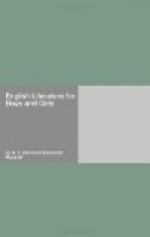With every new writer the story of Arthur grew. It seemed to draw all the beauty and wonder of the time to itself, and many stories which at first had been told apart from it came to be joined to it. We have seen how it has been told in Welsh, in Latin, and in French, and, last of all, we have it in English.
The first great English writer of the stories of Arthur was named Layamon. He, too, was a priest, and, like Wace, he wrote in verse.
Like Wace, Layamon called his book the Brut, because it is the story of the Britons, who took their name from Brutus, and of Arthur the great British hero. This book is known, therefore, as Layamon’s Brut. Layamon took Wace’s book for a foundation, but he added a great deal to it, and there are many stories in Layamon not to be found in Wace. It is probable that Layamon did not make up these stories, but that many of them are old tales he heard from the people among whom he lived.
Layamon finished his book towards the end of the twelfth century or the beginning of the thirteenth. Perhaps he sat quietly writing it in his cell when the angry barons were forcing King John to sign the Magna Charta. At least he wrote it when all England was stirring to new life again. The fact that he wrote in English shows that, for Layamon’s Brut is the first book written in English after the Conquest. This book proves how little hold the French language had upon the English people, for although our land had been ruled by Frenchmen for a hundred and fifty years, there are very few words in Layamon that are French or that are even made from French.
But although Layamon wrote his book in English, it was not the English that we speak to-day. It was what is called Early English or even sometimes Semi-Saxon. If you opened a book of Layamon’s Brut you would, I fear, not be able to read it.
We know very little of Layamon; all that we do know he tells us himself in the beginning of his poem. “A priest was in the land,” he says:
“Layamon was he called. He was Leouenathe’s son, the Lord to him be gracious. He lived at Ernleye at a noble church Upon Severn’s bank. Good there to him it seemed Fast by Radestone, where he books read. It came to him in mind, and in his first thoughts, That he would of England the noble deeds tell, What they were named and whence they came, The English land who first possessed After the flood which from the Lord came.
Layamon began to journey, far he went over the land And won the noble books, which he for pattern took. He told the English book that Saint Beda made. Another he took in Latin which Saint Albin made, And the fair Austin who baptism brought hither. Book the third he took laid it in the midst That the French clerk made. Wace he was called, He well could write. . . . . . . . . Layamon laid these books down and




